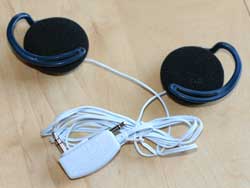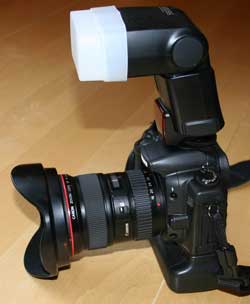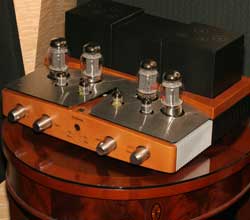|
Venue
The show this year was held for the first time in
the Le Centre Sheraton hotel in Montreal in what appeared to be a
mixed business / shopping district. The weather was quite nice,
relatively, and seemed to hover in the 40s with about a 15 mph
breeze that always seemed to come from the direction we were
walking
in.
We heard a number of wistful complaints that the
previous year's shows were in a hotel that had larger rooms, which
allowed systems to breath and develop their sound a little better
- not to mention having more room for the milling about of the
audiophiles.
Not having been to the show before, we can only judge the rooms
based on the generic audiophile-grade room-measuring guessometer - and the
rooms did indeed seem to be small, but not unlike the smaller rooms at the
RMAF: Rocky Mountain Audio Fest or CES - and they also seemed to
be relatively well insolated
from their neighbor's potential sonic excesses.
The Flight
Denver to Chicago to Montreal.
Air Canada / United was a smallish plane (two
seats each side of the center aisle) that had a little screen on
the back of the seat that one could play music videos or movies or
canned TV programs on. I was going to watch the new Dr. Who TV
show (again) but instead tried to watch the movie 'Zorro'.

Here are the definitely non-audiophile quality
throw-away headphones we got to use.
Let's see. Lean. Very lean. How lean was
it? It was so lean that
voices and all sounds sounded like metal clicking against more
metal.
Harmonic content non-existent. The
frequency range was limited to. oh, say to between 1000 and 2000
Hz. This meant voices and everything else was in this frequency
range. The bad part (yes there is a bad part) was that the planes
engine noise was so loud that one had to turn up the headset
volume quite a bit to hear anything. But then the pain of
the loud metallic clicking noise that was standing in for sound
forced one to turn down the volume. But then one couldn't
differentiate what was going on anymore from the sound of the
plane itself.
Hey at least I was able to jiggle the connector
some so I could get what I can only presume was dual mono. Poor
ole Neli
had to listen with only one ear.
After the movie server rebooted itself once - I
started laughing (I know enough about software to recognize a
persistent bug when I see it) and went back to reading my book. I
noticed two more spontaneous reboots, forcing everyone to
robotically use the touch screen to get back to the same place
they were in their movies before the crash. And this while just
happening to look up a couple of times while reading.
We thought our ears recovered pretty much entirely
by the last day of the show, which is when we do our most critical
listening.
Arrival
We arrived Thursday night. The show was to open
at 10:00 am Friday morning. We ran into a couple of people we knew on the way up to our room on the
8th floor. I do not know about you, but after a long plane
flight and customs and dodging flocks of wheeled carryons - the IQ
and ability to focus seems to drop to dangerously low levels. So after
not saying much and nodding and
smiling a lot we made it to our room.
The awesome thing
was that while making that beeline to the room, we couldn't help but
notice that right there, on our floor, was the Hansen / VAC /
Redpoint room. Say what? OK. Cool. One of the exhibit rooms was on
the same floor as our sleeping room!
Yeah, like perhaps most people
over the age of 35 or so, the thought that we
might end up somewhat sleep challenged being so close
to a room with high-powered (aka loud), albeit high-fidelity, sound
system did cross our
minds.
After the traditional
(for us) long detailed discussion about where we were going
to go eat, with as usual the clock running out forcing us to do
something, anything for food, we left the hotel to head over to
Chinatown. Lo and behold, as we left the room to head to the
elevators... Matey, thar be a boatload of
exhibition rooms on our floor! How cool is that?!
Skipping over the
mediocre dinner and subsequent marital recriminations about just
who was responsible for which parts of the decision tree that
ended up with us deciding to go to Chinatown, deciding to stop at
the first bunch of restaurants we saw, and picking out this
particular loser of a
restaurant that used frozen veggies for their vegetable dishes...
we got back to the room and got ready for the next day - hooking
up the laptop to the hotels internet etc.
As the hours rolled by
towards midnight,
we would hear, sometimes far off into the distance, sometimes
closer by, one system after another, sometimes two or three almost
simultaneously, getting fired up for the first time as they
finally got
everything hooked together and warmed up enough - blowing out the exhaust pipes as it were,
testing the limits of the room and system -
slowly quieting down over time as they figured it was satisfactory and ready
for tomorrow's opening day. Funny though, how the music of choice
for warming up a system was rock & roll, but this turned out
to be mainly a
Jazz and Classical music show.
Day One
The next morning, we were
out of the room at 10:00 am (Yes, really, 10:00 (ten!) in the morning.
Me. Who always sleeps in late... two timezones to the West) and
went straight to Tri-Cell's Brinkmann* room - which also
happened to be on our floor. Why Brinkmann? Because Neli wanted to
go and say hi and I figured we had to start somewhere, so I tagged along. The
show was still pretty empty - hardly any showgoers besides us two
- so they were kind enough in this room to let me snap a few million pictures,
allowing me to get a handle on the typical lighting situation that
we would be encountering at the show.
I really didn't pay much
attention to what I was hearing that morning. It was so
early. Neli and I soon split up, met up, and split up, and met up
again - more or less making it through the whole show that first
day together. It really helps to hear most rooms with a pal so you
can talk about what/how you each heard the various things you
heard later - to
both reinforce, highlight, and differentiate each others experiences. Kind of
like listening in stereo instead of just to stereo.
Took lots of photos, of
course. My apologies to all the show goers for the camera noise
and distracting flash. This camera has a loud shutter - or at
least is seems loud when it is so close to my ear - and any noise
at all is too much noise. But everybody seemed to more or less put
up with me and I hope they understand that the photos are for all
those people who could not make it to the show (and those who went
who did not get to see everything - or who went but have bad memories
like me!).
Photography Components

The camera setup I used
was a Canon 20D with a 580EX flash paired with a Sto-Fen
Omni-Bounce. I used the Canon 16-35L lens on full-auto for the
room shots and at f/11 with a shutter speed of 1/40 second at ISO
400 for most of the closeups (after doing almost 1000 test snaps
pre-show here on one of our systems in a similar, mostly
artificially lighted room, ISO 800 was found to be too grainy for
the type of crop and zoom work we do on some of the photos). We
also used a Canon EF 50mm 1.4 mostly at the same f/11 setting.
I used f/11 for both its sharpness and for its
someone deeper depth of field in order to get as much of the
typical faceplate shots in focus as possible. Yes, f/11 is
somewhat light-challenged so for especially problematic black
components it was stepped down to f/8 or so.
Finally, it is a truism that people we meet at
shows, both exhibitors and attendees, are such nice people that we
just want the show to go on forever. All the bickering about tube
versus solid-state, horn versus cone drivers, and the like is left
at home and on the web - and the shared interest in making sweet
music draws everybody together in each of these festive (but
also serious, of course :-) occasions.
We do not take pictures of people for our show
reports, thinking that people deserve what little privacy they can
get these days. And we have seen no studies that correlate the
attractiveness or the photogenic features of a designer with the
quality of sound that their products produce. Of course, if there
was a study that could show this then it might explain a lot :-)
Some of the coolest-looking stuff was on
static-display

Unison Research

David Berning

Pathos
This was a very good show from the point of
view of people who could not go. I mean by this people who go
through our photos of the show. This is because there were a lot
more things on static display at this show, more than any other we have
seen. I mean a LOT more. And when someone is going through the
photos of the show - they really do not care if power was supplied
to the component in the picture or not.
So in a real sense, this show was as large as
the largest show, CES. It is just that not all of the systems in
Montreal were plugged in and making music.
Use the stairs if you can
As usual at these things, the hotel elevators were useless
during the peak hours of the show.

Here we see audiophiles (and ordinary hotel
guests, the poor folks) milling around for up to 20 minutes
waiting for an elevator going their way.
Show Daze
What is it with shows that after the 1st day or
so I can't think straight?
I've been to enough shows to recognize this -
and I tell myself over and over:
"there is something you should be doing right
now. There is something you should be listening to and you know
you are going to regret it later if you space it out."
But for the life of me, at the time I just
can't figure out what these things are that I am supposed to be
doing. It becomes obvious later, after the show daze has warn off
- but, of course, then it is too late.
What were these things I was supposed to be
doing this show?
Listening more to the big Dynaudio room and the
Focus Audio / Vitus Audio room.
The Second Day The
second day I took the camera around using a different lens, the 50mm fixed focal length,
and re-visited the rooms that I remembered as have really cool
looking things I wanted to try and get a sharper photo of. This
included the Kharma speakers, HRS equipment rack and the Brinkmann turntable - both
because they are indeed cool looking but also for photos for the dealership
part of the website. Also included the Pathos CD player, the Sonus
Faber speakers (all of them) the big WAVAC amplifier and dCS
equipment stack in the Verity room, the Unison stuff in the Avalon room,
the Berning experimental preamp, etc. You get the idea. Some of
these came out to be really quite spectacular. And some not quite
as spectacular now even as good as with
the 16-35L lens. Next time, I think I will try and do another
complete circuit with the 50mm, though it is not wide angle enough to do
'whole system' shots, it can do most everything else. The real
problem is light. Not enough of it. Because all the things I want
to take pictures of are indoors. You will notice that most ads for
cameras and lenses have example photos taken outside. Where
there is lots of light. The crowd was the heaviest the second
day, Saturday. To the point where it was hard to get in to hear
things, or to take pictures. Luckily going to photograph just the
coolest looking things early in the morning was accomplished
before about 11 am when the crowds really started.
Waiting For the Sweet Spot There is this
funny technique to get in to hear a system during these busy
times. Often there are people packed into the room and even in the
entry way into the room. So one just stands there, and by
standing there one indicates one's interest in getting into the
room sometime in the near future. Then some people leave,
usually it is at least two and sometimes one or three. It is like
one person's exiting inspires others that it is either OK to
leave, or that they have heard enough, or that the exiting person
gives them confidence in their conclusion that the answer to Life,
the Universe and Everything is not to be heard in this room - on
to the next (well, that is what *I* listen for, don't you? :-).
So then one moves further into the entry way as people rearrange
themselves closer to the target - the target being The Center Seat
(hopefully somewhere near the sweet spot, though it is often in
front of the real sweet spot). Repeat. Repeat. Sometimes
one first accepts a lesser position, for example in the center of
the back of the room (mentally trying to discount possible bass
anomalies caused at that position), thinking that the time
required to get The Center Seat may not be worth it, and that
maybe the sound should be as carefully evaluated as possible from
a lesser location first to see if it is worth the investment of
more time in this room. One does not want to invest a half hour
to get The Center Seat in a room that sucks. Been there. Done
that. Don't do it anymore. There seemed to be the usual ratio of
women to men this show - about 10 - 15%. There seemed to be more
women downstairs than upstairs (the show was kind of divvied up
into two major sections: floors minus 2 through 4, and floors 7
through 11). The show ended at 7:00pm. This was a good time and
is about the time when I started getting hungry. The first day
ended at 9:00pm and I have to admit that we left around 7 to go
get something to eat. Hey, all that walking and lugging that
camera around makes a person hungry - even if it was only 5:00pm
Boulder time. Yes, we both felt guilty about leaving early when
there was more show to hear. Yes, we have a list of more excuses
available upon request - and only some of which we will make up at
that time - but we freely admit our guilt and plead, uh, wimpiness. We went to supper at a mixed Vietnamese, Thai and
Chinese food restaurant. Actually quite good. After hatching plans
to lay waste to the audiophile world as we all know it we got back
to the hotel way late. *I* spent the next two hours choosing,
photoshop'ing and uploading pictures to the daily show log on the
website while Neli slept and slept. :-)
The Third, and Last, Day This day I resolved to make
another pass through the show, mostly listening, but also taking
photos of things that I noticed did not come out too well the
previous nights as I was reviewing the photos for posting up on
the 'dailies'. Now, this can be somewhat misleading, as my
laptop has an old screen that does not show colors and shadows
very well. It helps if one looks directly at the screen,
but still... Anyway, I began to worry about the well-known
transitory state of data stored on computers, specifically the 4 GB or so
of photos I had just put on the laptop. So I resolved to go
shopping to get some CDROMs to back up the photos to. I had
also planned on getting some more batteries for the camera's flash
- as it had already drained one set and was nearing the death of
the second (my recharger, a Monster battery recharger at
that (yes, that Monster), weighs about 3 lbs - no kidding -
so I had decided not to bring it). Luckily, unlike the Las Vegas
strip, where everything is 10 miles from each other and there are
no stores in walking distance, Montréal had real stores and it was
only a mile or so until I found a cool little store that cold cool
stuff like old-style CDROMs that my slower computer can write -
and I now pine for a laptop with
a decent screen and a DVD recorder). At this store I also picked
up a Sony battery recharger, that not only came with better
batteries at about 1/2 the price, but also only weighed a few ounces.
Don't we love those Monster products? This day went quietly.
Much fewer people showed up than on Saturday. Did our final
listening, the results of which, room by room, are described in
the left hand side of this report, and called it a show. We left the next morning -
leaving behind a shell of a hotel. Quiet. Dead. Until next year
that is! |